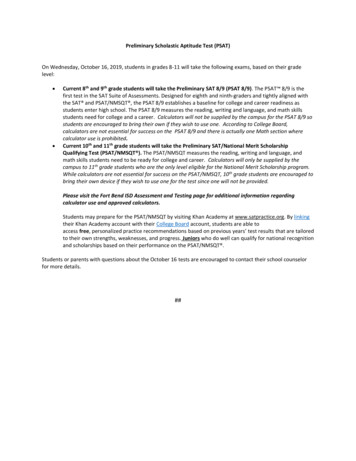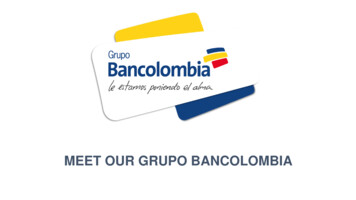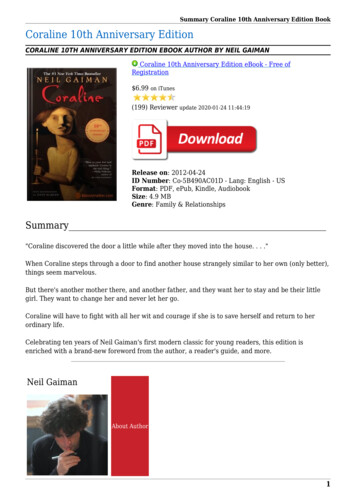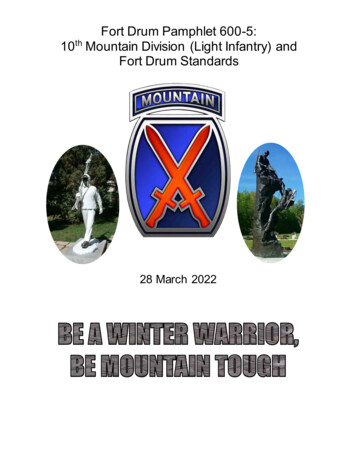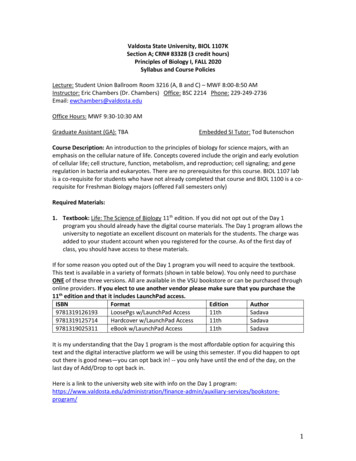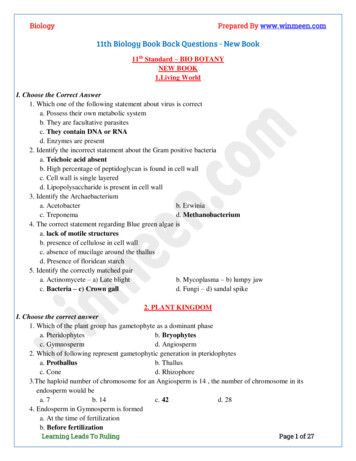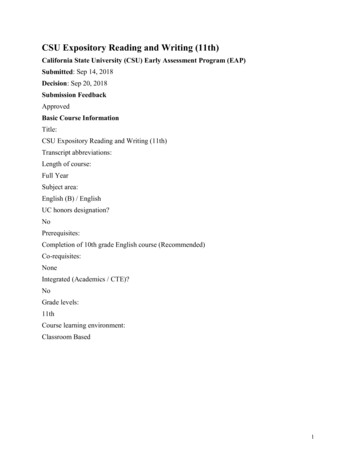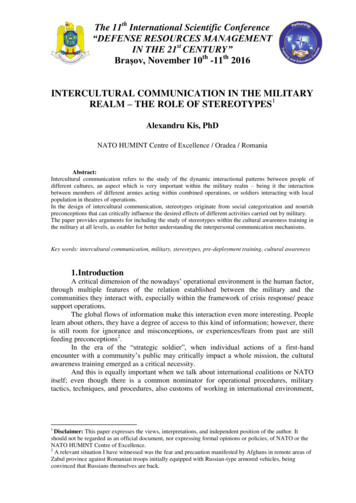
Transcription
The 11th International Scientific Conference“DEFENSE RESOURCES MANAGEMENTIN THE 21st CENTURY”Braşov, November 10th -11th 2016INTERCULTURAL COMMUNICATION IN THE MILITARYREALM – THE ROLE OF STEREOTYPES1Alexandru Kis, PhDNATO HUMINT Centre of Excellence / Oradea / RomaniaAbstract:Intercultural communication refers to the study of the dynamic interactional patterns between people ofdifferent cultures, an aspect which is very important within the military realm – being it the interactionbetween members of different armies acting within combined operations, or soldiers interacting with localpopulation in theatres of operations.In the design of intercultural communication, stereotypes originate from social categorization and nourishpreconceptions that can critically influence the desired effects of different activities carried out by military.The paper provides arguments for including the study of stereotypes within the cultural awareness training inthe military at all levels, as enabler for better understanding the interpersonal communication mechanisms.Key words: intercultural communication, military, stereotypes, pre-deployment training, cultural awareness1. IntroductionA critical dimension of the nowadays’ operational environment is the human factor,through multiple features of the relation established between the military and thecommunities they interact with, especially within the framework of crisis response/ peacesupport operations.The global flows of information make this interaction even more interesting. Peoplelearn about others, they have a degree of access to this kind of information; however, thereis still room for ignorance and misconceptions, or experiences/fears from past are stillfeeding preconceptions2.In the era of the “strategic soldier”, when individual actions of a first-handencounter with a community’s public may critically impact a whole mission, the culturalawareness training emerged as a critical necessity.And this is equally important when we talk about international coalitions or NATOitself; even though there is a common nominator for operational procedures, militarytactics, techniques, and procedures, also customs of working in international environment,1Disclaimer: This paper expresses the views, interpretations, and independent position of the author. Itshould not be regarded as an official document, nor expressing formal opinions or policies, of NATO or theNATO HUMINT Centre of Excellence.2A relevant situation I have witnessed was the fear and precaution manifested by Afghans in remote areas ofZabul province against Romanian troops initially equipped with Russian-type armored vehicles, beingconvinced that Russians themselves are back.
INTERCULTURAL COMMUNICATION IN THE MILITARY REALM –THE ROLE OF STEREOTYPESfrictions between soldiers – who often have to live together in military bases, not onlyjointly fighting – still can occur3.Efforts to mitigate negative effects of intercultural communication have beenintensively made in time in the military education, acquiring lessons learned and bestpractice from theatres of operations and exploiting them within the framework of predeployment training. The cultural awareness programs have embraced different forms,keeping in line with the conceptual advance (e.g. Human Terrain Systems,Counterinsurgency, Cross Cultural Competence, Comprehensive Approach, Civil-MilitaryInteraction, Civil-Military Cooperation, Human Environment, etc.); moreover, militarydomains like Human Intelligence (HUMINT) collection relies on advanced communicationskills performed by operators in relation with their sources, requiring a complex andsystematized curriculum to meet these expectations.The next chapters will briefly outline aspects of developing cultural competenceswithin the military, with emphasis on how stereotypes can be used as enablers forimproving inter-cultural communication.2. Cultural awareness in the pre-deployment trainingThe pre-deployment training is basically oriented toward familiarization of thesoldiers with the operational setting, the operation plan, tactics, techniques and procedures,legal aspects of the mission (rules of engagement, humanitarian law, law of the armedconflict), etc.Within this realm, the basic cultural awareness – starting from the requirement of anempirically-based pre-deployment training [2] – has marked a shift to "tactical culturetraining" or "operational culture learning" [3], tailored to the mission need.The subject of culture has emerged in parallel with the increased recognition on theimportance of the human factor in the battle space, which ultimately has led to embracingthe concept of “operational environment”. In this picture, culture is acknowledged as thelearned patterns of behavior and thought that help a group adapt to its surroundings,revealing itself in the beliefs, attitudes and behaviors of groups of people [4].The US Army JFK Special Warfare Center’s Political Military Analysis Handbook(2004) provides an analytical framework for looking at the “cultural factors” used by theUS Marine Corps and ABCA4, defining culture as “Learned and shared attitudes, values,and ways of behaving in a society; culture includes customs, folkways, manners,mannerisms, etiquette, behaviors, body language, gestures, celebrations, milestones, dress,outlooks, perceptions, and thought patterns. It is embodied in history, art, myths, legendsand heroes. It addresses appropriate responses to situations. It determines thecircumstances and quality of apology, retribution, reward, punishment, equity,commiseration, disdain, shame, guilt, congratulations and pride. It selects and appliessocial sanction and reward. It expresses itself in superstitions, outlooks, perspectives,conventional knowledge and points of view. It encompasses the sense of time, individuality,possessions, sharing, self-worth and group-worth. It establishes the social hierarchy,defining roles by sex, age, position, religion, wealth, family and profession. In essence,culture defines what is and is not okay, accepted, and normal” [6].3In a survey conducted on US troops, a large majority expressed negative experiences interacting withcoalition forces [1].4ABCA is a program aimed at optimizing interoperability and standardization of training and equipmentbetween the armies of the United States of America, United Kingdom, Canada, Australia, and New Zealand,plus the United States Marine Corps and the Royal Marines [5].
INTERCULTURAL COMMUNICATION IN THE MILITARY REALM –THE ROLE OF STEREOTYPESIn matters of cultural training, K. Trochowska marks a NATO "cultural turn" in2010, following the US pattern [7]; the new approach was summarized in therecommendations emerged from the Multinational Experiment (MNE) 6, goal 4.3, whichfocused on improving the efficiency of operations through the increase of culturalawareness of soldiers. However, an earlier study of the NATO Research and TechnologyOrganization (RTO), documenting the findings of Research Task Group 120, approachedthe increased cultural diversity within multinational military forces; it touched the point ofwhat O. Uifaleanu characterized as “inside the fences” cultural awareness, meant to servethe unity of effort between military allies and partners, including civilian actors [8].In spite of a series of “points of friction” that have been recognized as historicallyaffecting coalitions (differences in goals, logistics, capabilities, training, equipment,doctrines, intelligence, language, leadership, and cultural practices), the militaryorganization benefits of a supranational culture characterized as more collectivistic, morehierarchical and less salary-driven than the average civilian working culture; as aconsequence, military personnel of different origins can often work and live together 5without substantive problems [9].Regarding the relation with the “outside the fence” actors, if we consider the resultsof a survey that revealed about two-thirds of the responses pointing out challenging, if notnegative, experiences in interacting with local populations [10], the subject is of stringentattention.The declaration of the NATO summit in Warsaw [11] has emphasized theimportance given to education and training delivered to equip military with the necessarylevels of political, technological, cultural and sociological knowledge meant to enhanceregional understanding and situational awareness. Emerging from this, one of the AlliedCommand Transformation focus area is the development of the Human Capital – aprerequisite for enhancing individual performance in operations – fact that cannot omit thecultural training. This provision parallels an assumed responsibility over the way NATOrepresentatives, at all levels, deal with their counterparts.The Allied Command Transformation (ACT), recognizing the interaction with thehuman environment as a critical ability to be acquired and maintained, especially inmissions such as counterinsurgency, stabilization, reconstruction or security forcesassistance, tackles with developing a Human Environment Capability [12]. Supportplatforms are readily available to anyone in military and defense organizations, such as: theInnovation Hub Online Collaboration Platform [13], the Extended Hand: Cross-CulturalSkills Development Tool [14], the NATO Social Media User Open Online Course [15]and, in the close future, the NATO Cross-Cultural Awareness Massive Open OnlineCourse.The NATO’s champion in research and promotion of cultural interaction modelsbetween military and civilians is the NATO Civil-Military Cooperation Centre ofExcellence (CCOE). It proposes the concept of Cross Cultural Competence (CCC) as astep forward in apprehending the necessary level of cultural capability, trying to elude rigidinterpersonal behaviors or ethnocentric attitudes. CCC is defined as “ability to quickly andaccurately comprehend, then appropriately and effectively engage individuals from distinctcultural backgrounds to achieve the desired effect”. Its model is based on three pillars:‘cultural knowledge’ (cultural frameworks), ‘affect’ (attitudes toward other cultures andthe motivation to learn about and engage with them), and ‘skills’ (ability to regulate ownreactions in a cross-cultural setting, interpersonal skills, and the flexibility to assume the5In this case, continued interaction between contingents can, often, lessen the validity of stereotypes and helpto minimize possible negative outcomes.
INTERCULTURAL COMMUNICATION IN THE MILITARY REALM –THE ROLE OF STEREOTYPESperspective of someone from a different culture) (figure 1), and integrates in analysis thePMESII factors [16].Fig. 1 Cross Cultural Competence pillars [17]Beside this, there are many other initiatives dealing with the integration of humanfactors in military planning [18]. It is noteworthy to mention the project of NATOHUMINT Centre of Excellence – Human aspects of the operational environment – fundedby NATO Emerging Security Challenges Division (ESCD), which has brought asystematic view on what drives human attitudes and actions, provided an analyticalframework for the human environment, and determined landmarks for the complexity ofcross-cultural communication [19].It is already proven that a consistent theoretical knowledge on culture’s frameworkand solid cultural awareness for Intelligence personnel is even more important,representing a real functional area - especially for HUMINT operators (who interact withtheir sources in the effort to answer information requirements) and analysts (in their effortto understand the operational environment, process data and information and provideactionable and predictive Intelligence). Further on, decision-makers are equally interestedin balancing different courses of actions, driven by the desired effect. In this respect,cultural competence is critical for building and maintaining strategic legitimacy andcredibility throughout non-kinetic operations like Strategic Communication, InformationOperation, Psychological Operations, Civil-Military Interaction, etc., with a commondenominator in targeting communities.3. Stereotypes – a frame of human thinkingIntercultural communication builds on dichotomies generated by humaninteractions, such as: understanding vs. misunderstanding, agreement vs. disagreement,cultural adaptation vs. cultural isolation, conflict vs. cooperation, intercultural teamcohesiveness vs. team misunderstandings, intercultural projects success vs. projects failure,emotional improvement vs. emotional deterioration, and any other relational outcome [20].In this picture, a human interaction is naturally submitted to certain expectations –as well as preconceptions – of each of the actors involved, influencing their relation.Beside culture, biases founded on personal characteristics as age, gender, race, appearance,social class, occupation, wealth, materiel availability and equipment (specifically in the
INTERCULTURAL COMMUNICATION IN THE MILITARY REALM –THE ROLE OF STEREOTYPESmilitary) etc. may equally influence one’s behavior and, consequently, the communicationoutcomes, as they can create cultural barriers between individuals.Moreover, impending wants or mood, or external factors placing the communicatorin crisis (like time pressure) may influence the communication performance, as well.The understanding of all these factors, as well as an enhanced (learned) self-control,provide awareness and help prevent preconceptions and possible culture shocks, ormitigating negative outcomes of intercultural interaction (e.g. discrimination, hostilityleading to abuse of power), all capable to alter mission’s success.While interacting with people of different background, we become moreconsciously aware of our own culture and identity, which becomes more important to us; itis consequently used to evaluate and categorize others.O. Uifăleanu describes the „culture shock” encountered by deployed militarypersonnel equally relevant in relation with fellow soldiers from other contingents orexternal actors. In the first phase – the initial inter-cultural contact – soldiers mayexperience a “honeymoon” stage (behaviors are restrained and non-aggressive); continuingthe interaction, either sympathy or aggressive attitude may surface toward the “foreignculture”, upon the evolution of the stress of reconciling the cultural differences [21].A common response to this stress may include withdrawal and stereotyping the hostcountry. However, the time passing brings adjustment to the new condition (usually after 6months [22], which is a frequent deployment time), and even adaptation.A stereotype represents conventional, formulaic, and oversimplified conception,opinion, or image [23], positive or negative, used to categorize a group of people. Thefactual explanation is based on the circumstance when people, not understanding a certaintype of person (community, nation), put them into classifications, thinking that everyonebelonging to a reference group is alike. A stereotype often fixes and oversimplifies theimage or idea of the particular type of person or thing [24].There are many diagrams showing how people think and perceive other groups(figures 2 and 3), and a cosmopolite military organization like NATO is not excluded fromthis (similar pictures are circulated in NATO or coalition headquarters, wheremultinational staffs are present).Fig. 2 Stereotypes on European Nations [25]
INTERCULTURAL COMMUNICATION IN THE MILITARY REALM –THE ROLE OF STEREOTYPESFig. 3 Stereotypes on Nations’ problem solving approach [26]Of course, these examples are exercises of fun, but may be as well a finereproduction of real perceptions people have in relation with counterparts of differentculture. In this case, I raise the question if deterministic categories of analysis – as onebased on stereotypes6 – would necessary result in faulty assessments, or we can exploitstereotypes in our profit?4. Impact of stereotypes in the military; tips for cultural awareness/trainingThe social identity theory postulates that members of an in-group will seek to findnegative aspects of an out-group, thus enhancing their self-image [31] (“positive socialidentity”, self-esteem). Therefore, stereotypes not only regulate particular inter-groupinteractions, but are part of a broader cultural system that orientates our behavior in varioussocial contexts.Another function of stereotypes (the ”safety” hypothesis) resides in providing asense of control over our social contacts, helping us reduce uncertainty and avoid risksituations (both personal and social) [32].Stereotypes are not only a source of prejudice or discrimination; they might beuseful, if not unavoidable, in everyday situations. Stereotypes contribute to the cognitiveeconomy, providing a first set of attributes, particular to an alien culture, to any inquirer.6Concepts closely related to stereotypes are prejudice, discrimination and otherization. A prejudice is apreconceived opinion that is not based on reason or actual experience, thus a cultural ignorance [27]. Whilestereotypes can include both negative and positive characteristics, prejudice can be described as beliefs thatattribute negative characteristics, and they usually carry a more emotional component. Discrimination is thepractice of unfairly treating a person or group of people differently from other people or groups of people[28], which is usually prejudicial [29] to the discriminated group. Otherization is a linguistic construct usedto distinguish and identify (label) someone as belonging to a category, defined as "Other", or alien, different[30]. In practice, otherization excludes those persons who do not fit the norm of the social group, which is aversion of the Self.
INTERCULTURAL COMMUNICATION IN THE MILITARY REALM –THE ROLE OF STEREOTYPESKnowing common stereotypes about a society who is responsive on this, military personnelcan easier initiate interaction and establish contact with local counterparts, especiallyexploiting national or cultural clichés (with regard on a line of acceptability [33]) andsubtle and benign references to charming national idiosyncrasies.Even more, stereotypes are not exclusively a matter of communication, but one ofself-conscience. Complex social situations promote stereotypes as quick, effortless andeven adaptive answers [34] serving the social efficiency of an individual. Being aware onpotential stereotypes the counterpart has on the military force [7] or nation he represents,the military approach is fairly simple – having to reinforce as many as possible of thepositive stereotypes, and defeat the negative ones that do not apply to his person/ group.Being deployed in Iraq (Dhi Qar province) as CIMIC officer and interacting withboth fairly educated Iraqis, as well as with lower educated local people, I haveacknowledged lot of stereotypes in the way the local population judged the coalitiontroops. Romanians have been perceived as modest and peaceful characters (with a historyof bilateral relations during the authoritarian regimes of Ceaușescu and Saddam), while USand Italian troops have been negatively labeled (invaders, respectively lazy soldiers, notcommitted to support local communities [8]).In a way, it enabled Romanians’ freedom of movement (opening paths forsuccessful cooperation with elements of the local US units, securely embedded in our ownoutreach patrols), but it did not represent a lifeline for our forces (it happened thatstereotypes have been used as a – senseless – excuse for an attack against a Romanianpatrol, allegedly “confused” by some local “tolerated” insurgents with an Italian patrol).This is just a proof of how stereotypes can mislead if you strictly adhere to them.However, in this case, I have hardly worked with local authorities to removepreconceptions and to offer an accurate image of the facts. From this perspective, it iscritically important to be aware of stereotypes – if only to be able to avoid biases. Lessonlearned - positive stereotypes should not be over-valued, in the same way as negativestereotypes (although containing elements of truth) should not be ignored, but defeated.Fighting against prejudices involves better promotion of own values, improvedcommunication and self-exposure, raise of the intercultural (communication) competenceof the actors involved [36].***In Intelligence, stereotypes are present at multiple levels, starting from collectionand up to processing stage.In the collection effort, HUMINT is the most exposed as it involves interactionbetween operators and human sources, in a game where demeanor, behavior, message,gestures and other culturally-backed aspects are of paramount importance. It requires fromoperator integrity, receptivity to, and understanding of foreign points of view, as well asenough flexibility to adapt himself to the character of his (various) sources, while buildingrapport.The HUMINT operator has to be a subtle reader of biases or deception attempts,through a systematized process of source management (validating its credibility) andoverseeing information viability. In this respect, searching on stereotypes andpreconceptions the source may have over different subjects would offer priceless indicatorson how to deal with the data gathered and orient further collection. In Interrogation,7Regular stereotypes on military are described by Wolfe, Tom (2016) Career Coach's Corner: Use militarystereotypes to your advantage, in [35]8It sanctioned a perceived lethargic performance of the Italian Brigade responsible for the Dhi Qar provincein the reconstruction effort, compared to other provinces
INTERCULTURAL COMMUNICATION IN THE MILITARY REALM –THE ROLE OF STEREOTYPESstereotyping views and prejudices of the subject, if known, can be fruitfully exploited inthe process of data collection.Another challenge in this work is the use of interpreters, as often the local languageis not a common one. Besides mastering the technical relation with the interpreters, theoperator has to be aware that the interpreting/ translation work is also affected bystereotyping, as long as it supposes interposition between two (or even more) differentcultures. Besides his personal quality, manners and education, the interpreter has to beknowledgeable on all cultures’ traits involved in his job, and expert on decoding andaccurately modeling messages, in order to ensure a coherent and purposeful interaction,and react appropriately to abrupt changes in the behaviour of the counterparts, to guide thesupported military.Analysts are further confronted with processing and fuse data, where bias caninfluence the quality of the information provided; knowledge of source’s personalattributes, specifically the motivation9 (where prejudices are derived from), connected tothe subject of the information content, is definitely helpful in their work. However,erroneous products are still persistent, and contributing to this outcome is a series ofanalysts’ wrong interpretations and prejudices, including – among others – ethnocentrism,lack of empathy, projection of the ego, ignorance, or hypothesis of rationality/ irrationalityin the subject’s action, the preconception of proportional countermeasure, activism, thePollyanna (credulity and excessive optimism) or Cassandra (extreme/ unwarrantedskepticism) complexes, or routine thinking [37].5. ConclusionStereotypes have always accompanied the image of the military, and equallypreconceptions have always biased the soldiers’ view over the population in a theatre ofoperations.There is no standard, or a perfect model on how to deal in communicating with analien culture; it differs from person to person, at communities or organizations’ levels.Reactions, although related to a main culture, are settled throughout common sense – thusscarcely predictable – in concrete interactions between individuals. From this interactionsemerge the primary dimension of stereotypes, getting at the question: “will they hurt me orhelp me?” [38]For military, this question has a deeper significance, as they are exposed topermanent danger. Cultural specific knowledge is not enough to deal with this situation; ithas to be accompanied by understanding and adequate responses in complex situations.The management of intercultural messages has to consider the effects ofcommunication stereotypes on individuals and societies and follow different strategies toreduce negative outcomes. In this respect, it addresses aspects like: development of culturalsensitivity; anticipation of the meaning the receiver will get; careful encoding/ decoding;the multitude of communication supporting features; avoidance of slang, idioms, regionalsayings; selective transmission; relationship-building; receive and process feedback frommultiple parties; improve listening and observation skills; observe follow-up actions.Further on, the “serious games” embedded in pre-deployment training are an excellentopportunity to assimilate appropriate knowledge with the purpose of determining properbehavioral and attitudinal reactions [39]9On the other hand, a common practice in the social influence techniques is to educate attitudes andmotivation through a desired effect by cultivating stereotyping messages
INTERCULTURAL COMMUNICATION IN THE MILITARY REALM –THE ROLE OF STEREOTYPESOperationalization of culture has also to include the integration of universal culturalcompetence training into the overall career training development of military personnel[40].Involvement of Partner Nations can offer excellent opportunities to enhance culturalengagement of NATO troops and develop skills in environments genuinely reproducing theareas of operational interest. A relevant example is the Jordan offer to NATO and Partnersto train in its Peace Operations Training Centre elements of Allied and Partner forces, aswell as UN personnel, for deployment to Muslim countries [41].In this educational effort, lessons learned and best practice have to be consistentlyaddressed. As J. Chandler observes, the military would do a disservice to itself if it doesnot go back to the foundational body of existing knowledge, because the military will endup repeating mistakes or making decisions that are based on personal experience andpreferences [42].References:[1] Tebo, Christopher M. Pre-deployment cultural training: U.S. soldiers' perceptions ofpreparation for successful intercultural communication, New Mexico State University,2014.[2] Chandler, Jennifer V., Why culture matters: an empirically-based pre-deploymenttraining program, Naval Postgraduate School, Monterey, California, pdf, 2005.[3] Salmoni, Barak A., Advances in Predeployment Culture Training: The U.S. MarineCorps Approach, in Military Review, Vol. 86, No. 6, 2006.[4] Febbraro, Angela R.; McKee, Brian; Riedel, Sharon L., Multinational MilitaryOperations and Intercultural Factors, NATO Research and Technology OrganizationTechnical Report AC/323(HFM-120)TP/225 - Research Task Group 120, inwww.rto.nato.int, 2008.[5] https://en.wikipedia.org/wiki/ABCA Armies, consulted in 2016.[6] Chandler, Jennifer V., Idem, p. 36.[7] Trochowska, Kamila, International Experiences in the Operationalization of Culturefor Military Operations - Field Research Results, in Connections: The Quarterly Journal,Vol. 13, No. 3, ation, 2014.[8] Uifăleanu, Ovidiu L. (2010) NATO’s Comprehensive Approach – a challenge forcultural training, USAWC Strategy Research Project, U.S. Army War College, CarlisleBarracks, PA 17013-5050, 2010.[9] Febbraro, Angela R.; McKee, Brian; Riedel, Sharon L., Idem.[10] Tebo, Christopher M., Idem.[11] http://www.nato.int/cps/en/natohq/official texts 133169.htm, consulted in 2016.[12] apability-allied-commandserge-da-deppo, consulted in 2016.[13] http://www.act.nato.int/innovationhub, consulted in 2016.[14] http://www.act.nato.int/article-2013-1-19, consulted in 2016.[15] http://innovationhub-act.org/smcourse, consulted in 2016.[16] /cross-cultural-competence-ccc/, consulted in 2016.[17] 6/Cross-CulturalCompetence.jpg, consulted in 2016.
INTERCULTURAL COMMUNICATION IN THE MILITARY REALM –THE ROLE OF STEREOTYPES[18] Kis, Alexandru, Human Security and the Human Aspects of the OperationalEnvironment – A Systems View, pp. 221-235, in Teodor Frunzeti, Marinel-Adi Mustaţă(2012), Science in the Mirror - Towards a New Method of Paradigm Comparison, Éditionsdu Tricorne, Geneva, Switzerland, 2012.[19] Simion, Eduard; Surdu, Răzvan, Human Aspects in NATO Military Operations, CNICoresi SA, Oradea, 2014.[20] Trevisani, Daniele, Negoziazione interculturale. Comunicare oltre le barriereculturali (Intercultural Negotiation: Communication Beyond Cultural Barriers), FrancoAngeli Publisher, Milan, 2005.[21] Uifăleanu, Ovidiu L., Idem.[22] -adjusting-to-a-new-culture/,consulted in 2016.[23] http://www.thefreedictionary.com/stereotype, consulted in 2016.[24] sh/stereotype, consulted in 2016.[25] ermans.html, consulted in 2016.[26] vers-for-nato-in.html, consulted in2016.[27] udice TheMaskofIgnorance,consulted in 2016.[28] nation, consulted in 2016.[29] sh/discrimination, consulted in 2016.[30] CXOeT.99, consulted in 2016.[31] McLeod, Saul, Social Identity Theory, in http://www.simpl
INTERCULTURAL COMMUNICATION IN THE MILITARY REALM - THE ROLE OF STEREOTYPES1 Alexandru Kis, PhD NATO HUMINT Centre of Excellence / Oradea / Romania Abstract: Intercultural communication refers to the study of the dynamic interactional patterns between people of different cultures, an aspect which is very important within the military realm .
